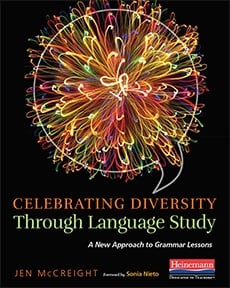
In Celebrating Diversity Through Language Study, author Jen McCreight introduces us to a new approach to grammar study, a subject area all too often taught without students and their unique backgrounds in mind. In this post adapted from Sonia Nieto's foreword to the book, we see the true importance of this kind of work in the everyday classroom.
By Sonia Nieto
Language is never neutral. Even in a first-grade classroom, language embodies and reflects particular power relationships and sociopolitical realities. This point is powerfully rendered in Celebrating Diversity Through Language Study, a teacher’s journey to self-awareness through language study with her young students. Walking what Jen McCreight calls “the tightrope between celebrating language diversity and recognizing linguistic bias,” this beautiful book tells the story of how a teacher can engage meaningfully with students on the many facets of language. While some educators may believe that the topics addressed in this book are too complicated for young children to appreciate, McCreight demonstrates not only that children can understand complex language issues but indeed that learning to do so can help young people make sense of the world.
—
This book respects children as capable of learning about the intricacies of language
—
Numerous educators and researchers have written about how a critical study of language can be used effectively with high school and college students. Bob Fecho’s Is This English? (2004) and Hilary Janks’ Literacy and Power (2010) are excellent examples. Vivian Vasquez’s Negotiating Critical Literacies with Young Children (2014) is one of the few that addresses language study and critical literacy with the very youngest students. Celebrating Diversity Through Language Study joins these books, providing another vivid example of how teachers can unleash the power of language even with young children. This book respects children as capable of learning about the intricacies of language, from creating their own terminologies to getting how language is used in different contexts. By using a variety of texts, whether translation charts created by children themselves or literature with which they can identify, the author describes numerous models of student-centered and caring approaches for teaching young children of diverse cultural and linguistic backgrounds. Throughout the book, McCreight repeatedly makes the point that context matters. Where, when, for what purpose, and with whom one speaks all matter a great deal, an important concept for even young children to grasp.
If only this book had been around when I was a child in elementary school! Not only would I have benefited but my teachers would also have benefited. Rather than helping me understand how to negotiate language or celebrate my native language in school, my teachers instead taught me to be ashamed of speaking Spanish and embarrassed about my Puerto Rican heritage. I wish I could say that things have changed dramatically in the past half century, but in many ways, they have not. While it is true that the situation has improved in many schools—particularly in places that support bilingualism and biliteracy, and in others where ELL classes are an integral and important part of a school—this is not the case in other places. Language diversity, if not a taboo topic in many of our schools, is often ignored. The very act of talking about language is a powerful strategy yet, given the rigid guidelines for teaching language arts that teachers have to follow, talking itself is discouraged in many classrooms. Children who speak languages other than English or varieties other than standard English are still regularly told to “leave it outside” or even forbidden to use their language altogether in school.
Jen McCreight’s first-grade students were fortunate indeed, for they were encouraged to explore language in all its forms. In the process, they learned that no language is a deficit language but instead that language in whatever form is a valuable and valid means of communication that must be cherished. Likewise, teachers fortunate to read this book will learn from the insights, perspectives, strategies, and many vivid examples included. Teachers of all backgrounds who teach students of all backgrounds will love this book.
Celebrating Diversity Through Language Study: A New Approach to Grammar Lessons is out now. Click here to learn more.
♦ ♦ ♦ ♦
Sonia Nieto is Professor Emerita of Language, Literacy, and Culture at the University of Massachusetts' School of Education. Her most recent Heinemann book is Finding Joy in Teaching Students of Diverse Backgrounds.
--
 Jen McCreight has eight years of experience teaching kindergarten and first grade, and is currently an assistant professor at Hiram College in Hiram, Ohio. She holds a Ph.D. in Language and Literacy Education from the University of Georgia.
Jen McCreight has eight years of experience teaching kindergarten and first grade, and is currently an assistant professor at Hiram College in Hiram, Ohio. She holds a Ph.D. in Language and Literacy Education from the University of Georgia.



